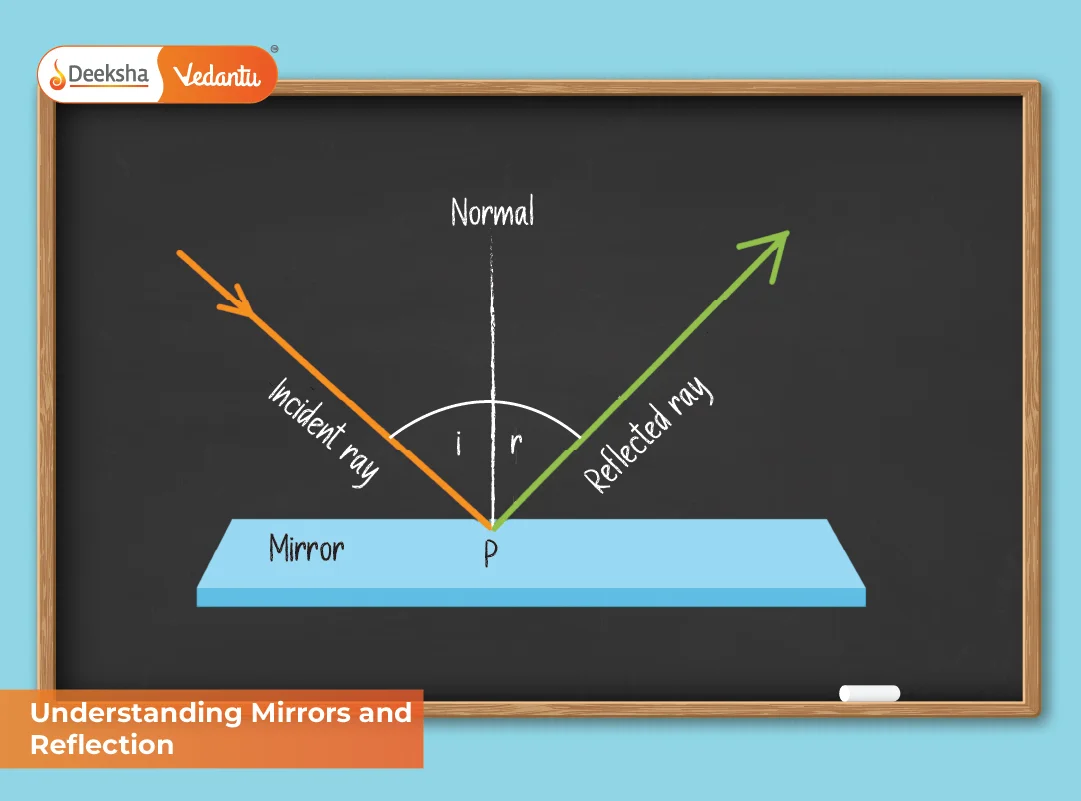Reflection is the bouncing back of light when it strikes a polished surface such as glass or a metallic sheet. It is one of the most fundamental principles in optics and is central to how we perceive the world through visual feedback. Whether it’s a car mirror, a dressing table mirror, or a telescope, understanding how light reflects from surfaces helps us comprehend image formation in both natural and artificial settings.
What is Reflection of Light?
Reflection occurs when light rays hit a surface and bounce back rather than passing through or being absorbed. The smoother the surface, the more defined and predictable the reflection. This concept forms the basis of image formation in mirrors and other reflective materials.
There are two major types of reflection:
- Regular Reflection: Occurs on smooth, polished surfaces like mirrors, resulting in clear images.
- Diffuse Reflection: Happens on rough surfaces where the reflected rays scatter in different directions, leading to no clear image formation.
Understanding this difference is crucial in explaining why some surfaces shine and form reflections while others don’t.
Laws of Reflection
The behavior of reflected light rays is governed by two foundational laws of reflection:
- Angle of Incidence = Angle of Reflection: The angle at which light hits the surface is equal to the angle at which it reflects away.
- Same Plane Law: The incident ray, the reflected ray, and the normal to the surface all lie in the same plane.
These laws are not just theoretical; they are consistently observed in real-world scenarios involving mirrors, water surfaces, and even metallic objects.
Learn more about the reflection of light
Types of Mirrors
Mirrors can be classified into several types depending on the shape of their reflecting surface and how they affect incident light rays.
Plane Mirrors
Plane mirrors have a flat reflective surface and follow all the basic laws of reflection. They form images that:
- Are virtual (cannot be projected on a screen)
- Appear upright
- Have the same size as the object
- Are laterally inverted
Commonly used in homes, optical instruments, and public restrooms, plane mirrors are often the first type introduced to students.
Spherical Mirrors
Spherical mirrors are portions of a sphere and have curved reflective surfaces. They are of two main types:
Concave Mirrors
- Curved inward like the inside of a spoon
- Act as converging mirrors
- Reflect parallel rays of light to a single point called the focus
These mirrors can produce both real and virtual images depending on the object’s position relative to the mirror’s focal length.
Convex Mirrors
- Curved outward like the back of a spoon
- Act as diverging mirrors
- Cause parallel light rays to spread outward
They always form virtual, erect, and diminished images, making them highly useful for applications that require a wider field of view.
Explore more about spherical mirrors
Mirror Images Explained
Understanding how images are formed by different types of mirrors is key to mastering optics. Image characteristics depend on several factors:
- Type of mirror (plane, concave, or convex)
- Position of the object relative to the mirror
- Distance between the object and the mirror’s surface
Real Images
- Formed when the reflected rays actually converge
- Can be captured on a screen
- Usually inverted
- Produced mainly by concave mirrors when the object is beyond the focal point
Virtual Images
- Formed when reflected rays appear to diverge from a point behind the mirror
- Cannot be projected on a screen
- Always erect
- Commonly produced by plane and convex mirrors
Ray diagrams are often used to understand image formation and help in predicting the position, size, and orientation of the image.
Understand mirror image formation in detail
Uses of Concave and Convex Mirrors
Mirrors have practical applications in daily life, science, engineering, and safety systems. The selection of concave or convex mirrors depends on the desired outcome in terms of image characteristics.
Uses of Concave Mirrors
Concave mirrors are employed where focused light or magnified images are required:
- Shaving and Makeup Mirrors: Provide a magnified image when the face is close to the mirror.
- Dentist Tools: Help view an enlarged image of the teeth and gums.
- Solar Furnaces: Focus sunlight to a small point to generate heat.
- Reflecting Telescopes: Gather and focus light from distant stars.
- Flashlights and Headlights: Direct light into a parallel beam using a focal point.
Uses of Convex Mirrors
Convex mirrors are widely used for safety and security purposes due to their wide field of view:
- Rear-View and Side-View Mirrors: Help drivers monitor traffic behind them.
- ATM Booths and Elevators: Offer visibility of surroundings for safety.
- Roadside Mirrors: Provide better visibility at blind spots and curves.
- Supermarkets and Stores: Enable surveillance in large open spaces.
Detailed uses of concave and convex mirrors
How Human Eye Perceives Mirror Images
The human eye detects light rays that either come directly from an object or reflect off surfaces like mirrors. In the case of mirror images:
- Virtual images appear to be located behind the mirror, even though no light actually exists there.
- Real images form on screens or surfaces where light rays converge.
The eye processes the reflected light to reconstruct the object’s shape, size, orientation, and distance, often assisted by binocular vision. Understanding how the eye perceives images complements the study of mirrors and reflection in the broader topic of vision and light.
Understand human eye structure and image perception
FAQs
Q1.What are the main types of mirrors?
The three main types of mirrors include plane mirrors, concave mirrors, and convex mirrors. Each type has distinct characteristics and applications based on the shape of the reflective surface.
Q2.What are the laws of reflection?
1.The angle of incidence is always equal to the angle of reflection.
2.The incident ray, the reflected ray, and the normal all lie on the same plane.
These laws are universal and apply to all reflective surfaces, whether smooth or curved.
Q3.Where are concave mirrors used?
Concave mirrors are used in devices and applications that require focused or magnified light, such as headlights, telescopes, dental mirrors, solar cookers, and shaving mirrors.
Q4.Why are convex mirrors used in vehicles?
Convex mirrors provide a larger field of view compared to flat mirrors, which helps drivers see more of the road and surroundings. This improves safety, especially when reversing or changing lanes.
Q5.What is a virtual image?
A virtual image is formed when reflected light rays diverge and do not actually meet. These rays appear to come from behind the mirror. Virtual images are erect and cannot be projected on a screen.
Q6.Can concave mirrors form both real and virtual images?
Yes, depending on the position of the object. If the object is placed beyond the focal point, a real and inverted image is formed. If it is placed between the focal point and the mirror, a virtual and magnified image is formed.
Q7.Do all mirrors produce lateral inversion?
Plane mirrors do. They reverse the image from left to right, a phenomenon called lateral inversion. This is why text appears backward when seen in a mirror.
Conclusion
Mirrors are more than just reflective surfaces; they are powerful tools that demonstrate the core principles of light behavior. From personal grooming to sophisticated scientific equipment, mirrors help us harness and understand the power of light. By studying the laws of reflection and the properties of mirror images, students gain not only textbook knowledge but also insight into the physics that shapes our visual experiences.
A solid understanding of different types of mirrors, image formation, and practical uses prepares learners for more advanced topics in optics and physics. Whether it’s the simple plane mirror in your bathroom or the giant concave mirror in a telescope, the principles remain the same—and equally fascinating.
Table of Contents










Get Social